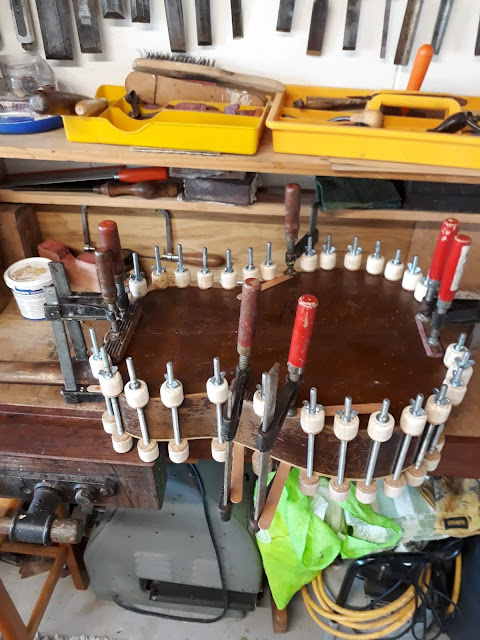This 1977 Maton CW 80/6 is easily the the most damaged guitar that I have ever attempted to repair.
I took it on as a challenge and because I like the owner so much, besides which the back has Keith Richard's signature scrawled across it!
The owner had attempted to repair it himself but I had my work cut out just undoing his efforts before I could begin the repair. The back had come completely apart, the result of exposure to moisture. Every glue line to every single component in the back had let go. The owner had re-secured it all with PK screws.
 |
The action was very high, the result of belly in the bridge (over 3 mm)
The owner had removed the saddle and rebated it into the soundboard! This was something I had no desire to touch. |
 |
| Here is an example of a brace smothered in hot-melt glue. |
 |
| Please don't attempt your own repairs if you don't know what you are doing, it makes it so much harder to repair. |
 |
| The original label and model number. |
 |
Maton had driven a holdfast nail into the heel of the neck!
With the back removed I was able to punch it out from the inside. |
 |
| Neck block |
 |
| X bracing was loose in one spot to the left of the sound hole. |
 |
No reinforcement around home cut preamp slot and insufficient bracing for the bridge string holes.
This area had pulled upward an alarming amount. |
 |
The owner had drilled an oversize hole to accommodate the Fishman tailpiece
resulting in a stress crack in the tail block which (incidentally) has the grain running the wrong way. |
 |
I glued a wall nut veneer over the split after first glueing and mending the crack.
This reinforces the block. |
 |
I added a fillet of birch ply to the preamp slot cutaway.
I also glued a cherrywood reinforcing block under the bridge. |
 |
| I cleaned up the mess on the braces and began the process of reassembly. |
 |
The two halves of the back are reconnected and the joint reinforced with wall nut battens.
the braces start to go back on. |
 |
| The assembled back ready to be glued back on the body of the guitar. |

 |
| I made 30 spool clamps which proved ideal for the replacement of the back. |
 |
I decided to remove the finger board as I could not understand the neck joint.
This is unique to this Guitar. There is no one at Maton that recalls how this joint should be separated.
I tried conventional methods but no luck. |
 |
| The truss rod extends all the way to the sound hole while I have never seen before. |
 |
| Close up of the truss rod. |
 |
Because the neck would not come off my only option was to make a long wedge under the fingerboard.
I fabricated this out of .5mm laminated of maple stepped gradually from zero at the nut to 3 mm at the sound hole. |
 |
| Once cured I sanded it fair and straight. |
 |
| I then re glued the finger board. |
 |
| The owner wanted to retain the road worn aesthetic of the guitar so I settled on re coating it in several layers of shellac and a couple of coats of gunstock oil on the back, sides and neck to protect the bare wood. |
 |
Reassembled with a new ebony saddle with string height and action adjusted, the intonation is perfect and it
plays like a new guitar with all the tone and character that it has accumulated over the last 44 years. |

































1 comment:
Magnificent work.
Post a Comment